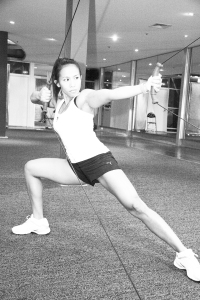Author: Amanda Carlson
Editors Notes: Amanda states that carbohydrates are “easily stored as fat.” While this is not the truth, they do inhibit the breakdown of fat. We will touch on this in the next blog. We don’t fully agree with some of the views expressed in this blog but feel it is well written for a general understanding of carbohydrates.
Overview
Along with protein and fat, carbohydrates are one of the three main classifications of foods (macronutrients). A main source of energy for the body, carbs are mostly sugars and starches that the body breaks down to the simple sugar glucose to feed its cells. There are, on average, four calories per gram of carbohydrate.

Tetra Images / Getty Images
Carbs provide energy for muscle function and act as the primary fuel for the brain. Carbs like whole grains, fruits and vegetables are rich in fiber, so they help control appetite, slow digestion and improve heart health. Processed carbs, on the other hand, such as white breads, pastas and baked goods, provide little nutritional value and are converted quickly to sugar and easily stored as fat.
There is a trend to categorize carbohydrates into “good carbs” and “bad carbs.” The science behind the categorization is the glycemic index or glycemic load.
The “good carbs” are typically those that are high in fiber and less processed (whole grains, fruits, and vegetables) with the more official name of low glycemic index carbohydrates. The glucose from these types of carbohydrates is released slower, therefore providing energy for a longer period and producing less of an insulin spike.
The “bad carbs” are those that are typically more processed (white breads, pretzels, candy) or high glycemic index carbohydrates. The glucose from these carbohydrates is quickly released, causing an insulin spike and the quick removal and shuttling of glucose from the blood stream into the cell.
For an active person, both the high and low glycemic index carbohydrates are important for ensuring a proper amount of energy for optimum performance. The trick now is figuring out the timing. It is optimal to have lower glycemic index carbohydrates in your meals throughout the day and before training or activity. During intense and prolonged exercise (exercise lasting an hour or more), it may be advantageous to have a high- glycemic-index sports drink to maintain blood glucose levels. The optimal time to have higher glycemic index foods is when you have finished your exercise or activity. After activity, there is about a two-hour window of optimal recovery. During these two hours, your cells are most receptive to nutrition to replenish the glycogen stores that you have depleted. The replacement of these stores is crucial for the next workout.
The place where people often go wrong is eating too much carbohydrate—or just too much of anything. Different sports require different amounts of available fuel. The marathon runner is going to need much more fuel than the golfer, so each type of athlete needs to base his or her carbohydrate intake throughout the day, before, during, and after their exercise or event on their actual activity level. Even regular exercisers need to base their carbohydrate intake on the amount of activity they are engaging in. If you are enduring longer, harder workouts, you need more carbohydrate. If your workouts are less intense, you need less carbohydrate.
A healthy portion of carbohydrates should be about the size of a baseball. Here are some examples of standard serving sizes of carbs:
- 1 slice whole grain bread (whole wheat, pumpernickel, rye)
- 1/2 of a hamburger bun (whole wheat )
- 1/2 of an English muffin (whole wheat or sourdough)
- 1/2 of a whole-grain bagel
- 3 cups popped light popcorn
- 1/2 cup cooked oatmeal
- 1/2 cup cooked rice (brown)
- 1/4-1 cup of dry cereal depending upon type (high fiber)
- 1/2 cup cooked vegetables
- 1/2 cup mashed potato
- 1 small (3 ounce) baked potato
- 1/2 cup cooked lentils, split peas, or beans
- 1 small apple
- 1 medium banana
- 3/4-cup blueberries
- 1/2 grapefruit
- 1 medium orange
- 1 cup cubed cantaloupe
- 1/4 cup cubed watermelon
- 2 tablespoons of dried fruit
Fruits and vegetables contain powerful antioxidants, helping to protect the body from the cell-damaging effects of free-radicals:
Apples, avocados, beets, bell peppers, black beans, blackberries, blueberries, broccoli, Brussels, sprouts, cantaloupe, carrots, celery, cherries, cucumber, eggplant, field greens, grape fruit, green apple, green beans, green peas, honeydew, kiwifruit, mangoes, mushrooms, oranges, papaya, peaches, pine-apple, plums, pomegranates, raspberries, red grapes, romaine lettuce, snap peas, soybeans, spinach, squash, strawberries, sweet potatoes, tomatoes, watermelon, yams
- Brown rice
- Cheerios
- Couscous
- Kashi
- Oatmeal
- Pumpernickel bread
- Quinoa
- Rye bread
- Sourdough bread
- Whole wheat bread
Fiber, found mostly in carbohydrates, is essential to overall health. It improves gastrointestinal health and function and helps prevent colon cancer, regulates blood sugar, and promotes long-term cardiovascular health by reducing cholesterol. People who follow low-carb diet plans deprive themselves of this vital source of nutrition. Non-processed, fiber-rich, colorful carbs are essential to a healthy lifestyle. Eliminating carbs produces sluggishness, along with long-term negative health effects. Try to consume a lot of fiber. Fiber improves your body’s digestive function, regulates blood sugar levels, and promotes long-term cardiovascular health.
Fiber is found in oatmeal and green, leafy vegetables, beans, whole grain products, as well as in bottled form. You can sprinkle it on your meals to improve their nutritional value. Because fiber is found mostly in carbohydrates and is essential to overall health, people who follow low-carb diet plans are depriving themselves of this vital source of nutrition.
Several popular diets advocate that you don’t eat carbs, and that’s one way to lose a lot of weight in a hurry. After all, for every gram of carbohydrate we eat, we store 3 grams of water. But that’s a good thing since it keeps us hydrated and satiated.
If you go on one of those diets without carbs, it’s like taking a sponge and wringing the water out. You’ll lose the water weight, but as soon as you eat carbs again—and you will at some point, because you need energy to function, and you can only go so long without carbs—then the sponge is going to fill up with water. Research shows that the weight will come right back, and with a vengeance; people often gain back all the weight they lost while following a diet that severely reduces carb intake—and more. As with dieting, you’ll likely lose some of your lean mass in the process.
In addition to the decrease in performance associated with low carbohydrate diets, those following the low carbohydrate diets often omit many of the high-fiber whole grains and the vitamin, mineral and phytochemical loaded fruits and vegetables.
A better approach is to eat carbohydrate based on your activity level and understand what makes up an actual serving size of carbohydrate. Carbohydrate equals fuel, and the body prefers glucose (what the carbohydrate is broken down into) for energy to fuel both the muscles and the brain. Without enough carbohydrate you are bound to sputter along like a car that is about to run out of gas. This becomes particularly important to the athlete who needs to have a full supply of energy at all times. During exercise or sports activities, the body will use available glucose in the blood for energy. Once that supply of glucose is depleted, the body will begin to break down glycogen, which is stored glucose, for energy. After that is gone, the body no longer has an efficient way to release glucose and your ability to perform at a high level will be compromised.
Throughout the day and before training, choose mainly lower glycemic index carbohydrates including high fiber whole grains and fruits and vegetables. After your training, eat enough carbohydrates by choosing some higher glycemic index carbs to replenish your glycogen stores. By using carbohydrate as your training and performance partner and not as the forbidden nutrient, your energy stores and your diet will achieve a more appropriate balance.
Tags: Food, Carbohydrate
- Verstegen, Mark, and Pete Williams. Core Performance Essentials: The Revolutionary Nutrition and Exercise Plan Adapted for Everyday Use. Pennsylvania: Rodale Press, 2006.
- Verstegen, Mark, and Pete Williams. Core Performance Endurance: A New Fitness and Nutrition Program that Revolutionizes The Way You Train for Endurance Sports. Pennsylvania: Rodale Press, 2007.
http://www.coreperformance.com









